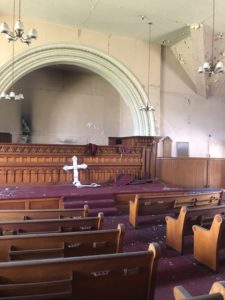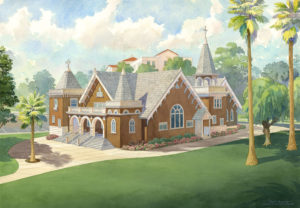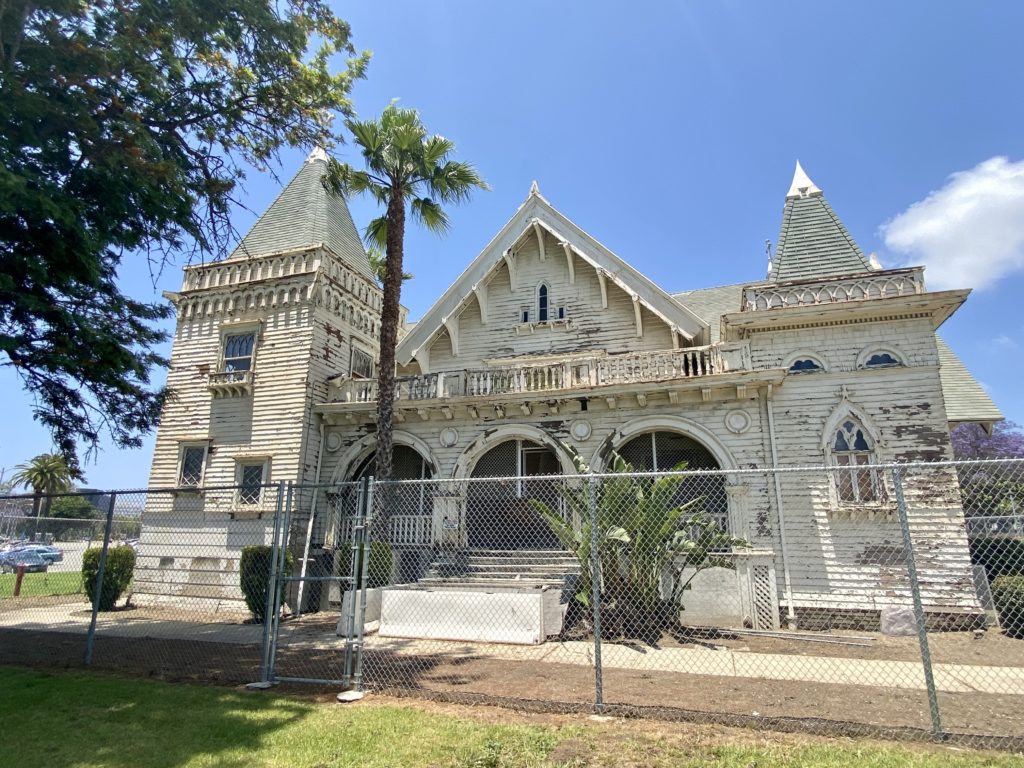The last time Msgr. Lloyd Torgerson paid a visit to the Wadsworth Chapel on the Veterans Administration’s (VA) north campus in West LA was last April, off the heels of a record-breaking rainy season in the region.
He wasn’t very encouraged by what he saw.
“It was a mess,” said the pastor at St. Monica Church in Santa Monica. “I was allowed to go inside and look around. Pretty bad.”
But he wasn’t discouraged, either, considering all that is happening to finally rejuvenate the original “spiritual and community center” of the VA campus.
When the regal building recognizable for its late-Victorian style opened in 1900, it did so well before most of Wilshire Boulevard had even been paved, or UCLA in nearby Westwood had been founded. Many of the veterans who worshipped at the chapel were men who’d been encouraged to move West after the Civil War to seek a new beginning.
A double-brick wall inside the chapel created two distinct entrances — one on the south and one on the north. From the south side, Protestants gathered to practice their faith. The north side was for the Catholic Masses, coming up in a grand staircase entry.
Following years of neglect, it has remained closed since damage suffered from the 1971 Sylmar earthquake. It is surrounded by temporary fencing because, at a time when many of the homeless population around the area seek shelter, it has been exposed to fire and vandalism.
Now, a coalition of local faith leaders — including Torgerson — are working to revive it.
Officially, they are called Wadsworth Chapel Heritage Partners, bringing together nonprofit groups The Veterans Collective and The 1887 Fund to lease the property.
The plan is to keep its original structure intact, convert the south side into an interfaith gathering space, and make the north side the home of the new Center of Moral Injury Recovery, focused on healing veterans who need holistic care for inner wounds suffered during their time in service.
To date, government grants and local foundations have contributed to the estimated $28.5 million expected to restore it. The restoration is part of a campaign to restore five key buildings on the West LA VA campus in time for the 2028 Summer Olympics in LA.

Christine Barrie, a St. Monica parishioner, has a deep-rooted family commitment to this project.
Barrie’s late mother, Carolina, was the grand niece of Arcadia Bandini de Baker, who in 1887 joined partner John Jones, a senator from Nevada, and donated 825 acres of land in West LA. to start the Pacific Branch of the National Home for Veterans, which included the land for the historic VA cemetery. It was all part of the country’s westward expansion under a program established by President Abraham Lincoln.
Some 20 years ago, Carolina hosted Torgerson, then-LA mayor (and St. Monica parishioner) Richard Riordan and several noted architects at her home for a brainstorming session. In 2015, after watching program after program fail, she created The 1887 Fund for this latest push.
“We have always seen the chapel there on the hill as a beacon of hope,” said Christine Barrie. “It is the heart of the property. Many vets stop by to ask about it. When you tell them we’re the organization putting it back together, the excitement is palpable. There is a light at the end of this tunnel.”
Christine recently hosted a gathering of the Interreligious Council of Southern California, which includes Rt. Rev. Alexei Smith, who heads the Ecumenical and Interreligious Office of the Archdiocese of Los Angeles.
“I am honored to be invited to provide input as to the design and makeup of the chapel,” said Smith.
Smith noted that members of today’s armed forces are not just Protestants and Catholics — but also adherents to the Jewish, Muslim, Hindu, and Buddhist faith traditions.
“I think it most appropriate that the restored chapel — if there is only to be one chapel — be an interfaith chapel,” Smith told Angelus.
The other building’s other side, meanwhile, would be the first of its kind on the West Coast. Moral Injury Recovery, identified in the 1990s, is a construct that has some overlap with the better-known Post Traumatic Stress Disorder (PTSD) and has similar components of depression, anxiety, and substance abuse. Moral injury differs in that it stems from spiritual distress that leads to guilt, shame, social alienation, and difficulty with forgiveness.
“There are paths to healing and well-being and feeding our spiritual self,” said Tess Banko of The Veterans Collective.
A Marine veteran, Banko is the collective’s therapeutic community project director. She believes the building will provide “a home for veterans of many paths they are walking toward spiritual care and healing.”

Father Tim Meier, a Jesuit priest who served 14 years as an Army chaplain with experience counseling trauma survivors, is among those set to work at the center. He currently spends time at the VA campus counseling veterans while serving as chaplain at Children’s Hospital LA.
At one point in the 1960s, the VA campus in West LA had 5,000 residents, but now it is less than 500. It is estimated there are 4,000 unhoused veterans currently in LA County.
Msgr. Torgerson believes the building can play an “essential” role in meeting the spiritual needs of veterans,” said Torgerson. “We are happy to be part of the interfaith community participating in the restoration efforts and help provide opportunities for spiritual nourishment.”
The Wadsworth Chapel falls within the clerical boundaries of St. Sebastian Church just north of the VA Medical Center. Yet Torgerson protects the historic connection to St. Monica, established in 1886 as the closest parish to downtown LA at the time. Hence, St. Monica was declared the patron saint of the Wadsworth Chapel.
In fact, it was St. Monica’s then-pastor, Father Patrick Hawe, who joined Bishop George Montgomery, the newly named shepherd of the Monterey-Los Angeles Diocese, to pray in the chapel’s Catholic sanctuary at a 9:30 a.m. Sunday service on March 18, 1900.
“Our community has this project close to its heart and it’s important for our participation,” said Torgerson. “Everyone’s spiritual journey is an important part of their lives, especially for these men and women who come to the VA seeking community and assistance. We have to help them.”

